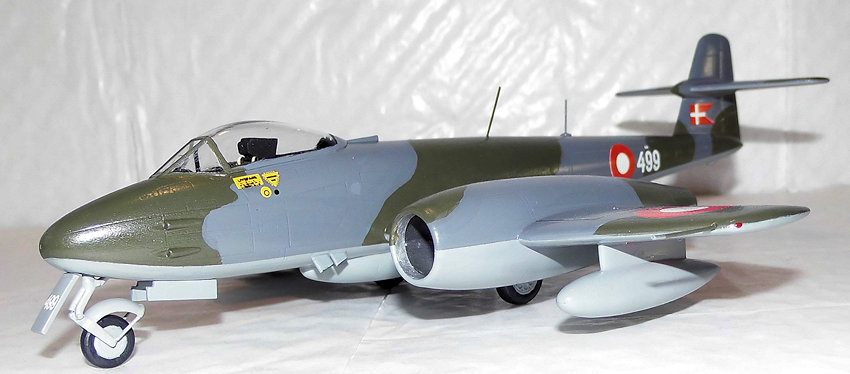
| KIT #: | A03076 |
| PRICE: | $ |
| DECALS: | Several options |
| REVIEWER: | Nicolai Plesberg |
| NOTES: | Used mixed Stoppel decals / kit decals |

| HISTORY |
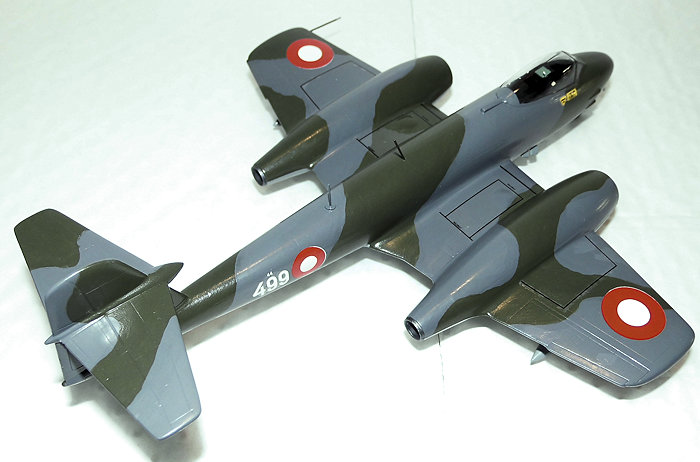 The Gloster Meteor was the
first operational British jet fighter, which entered service in July 1944 with
the primary task of chasing flying bombs (the V1) and in the more developed Mk.
III variant also ground attack. The two aircraft that might be considered as the
F.Mk IV (later F. Mk. 4) prototypes was two specially build Mk. IIIs, EE 454 and
EE 455, fitted with the prototypes of the Derwent 5 engine, which became the
standard power plant for the production machines. In the late 1940s the F.Mk.4
became widely exported. Argentina, Belgium, Denmark, Egypt and The Netherlands
took delivery of some 240 aircraft altogether.
The Gloster Meteor was the
first operational British jet fighter, which entered service in July 1944 with
the primary task of chasing flying bombs (the V1) and in the more developed Mk.
III variant also ground attack. The two aircraft that might be considered as the
F.Mk IV (later F. Mk. 4) prototypes was two specially build Mk. IIIs, EE 454 and
EE 455, fitted with the prototypes of the Derwent 5 engine, which became the
standard power plant for the production machines. In the late 1940s the F.Mk.4
became widely exported. Argentina, Belgium, Denmark, Egypt and The Netherlands
took delivery of some 240 aircraft altogether.
By 1947, however, with the
introduction of such fighters as the Soviet MIG-15 and the American F-86 Sabre,
which were superior in performance to the Meteor, Gloster took the opportunity
to improve the Meteor F.Mk.4, so it didnít lack so much behind fighters of other
nations. Especially in the field of performance of turbojet engines, which in
the immediate post war years had taken such a gigantic leap forward and was the
primary success of the competitors of Britainís aviation industry. So Gloster
took the basic Meteor F.4, gave it a fuselage stretch, increased fuel capacity
and redesigned the tail unit,
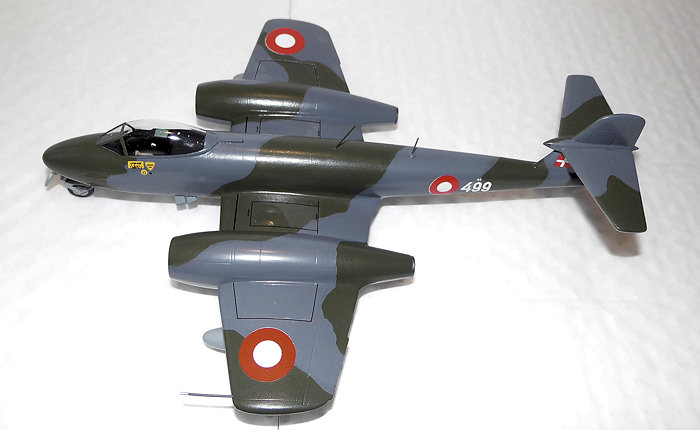 gave it more powerful engines, more electronic
equipment to better mission performance and, as a first in the Meteor family, an
ejection seat. The new fighter variant was designated the Meteor F.Mk.8 and
entered service in the RAF in 1950. Of course the F.8 was also exported to
several other countries such as Belgium, The Netherlands and Denmark.
gave it more powerful engines, more electronic
equipment to better mission performance and, as a first in the Meteor family, an
ejection seat. The new fighter variant was designated the Meteor F.Mk.8 and
entered service in the RAF in 1950. Of course the F.8 was also exported to
several other countries such as Belgium, The Netherlands and Denmark.
The Danish government bought 20 Meteor F.8 in April 1950 and deliveries began the following January. The aircraft served with the newly established Eskadrille 724 (Squadron 724) at Karup and they got the type numeral 44 and individual numbers running from 481 to 500. In 1952 the Squadron moved to Aalborg, where it stayed for the next six years. As Eskadrille 724 exchanged its Meteor F.8s for Hawker Hunters in 1956, the Meteors got new assignments such as liaison and training flights as well as performing target tug duties. Of the 20 delivered Meteor F.8 three where lost in crashes, several were during the late 50s / early 60s scrapped / used in fire drills and the last flight of a Meteor F.8 in Danish service took place in September 1962.
| THE KIT |
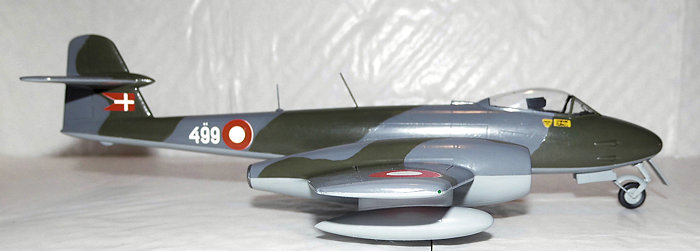 This kit, I believe, is the
first injection molded kit of the Meteor F.8, since Frog released one ancient
times ago. (Actually, Merlin released this in their
catalogue, but it certainly was not a mainstream injected kit. Ed) All parts are cleanly molded with fine recessed panel lines. Very
little flash is present here and there and some sink marks present on especially
the gear parts. However, with a little experience this should be a relatively
trouble free build. As with all short-run kits I suspect a great deal of filling
/ sanding sessions will be needed, but if you will know how it all turned out,
you must read the next sections of this review!
This kit, I believe, is the
first injection molded kit of the Meteor F.8, since Frog released one ancient
times ago. (Actually, Merlin released this in their
catalogue, but it certainly was not a mainstream injected kit. Ed) All parts are cleanly molded with fine recessed panel lines. Very
little flash is present here and there and some sink marks present on especially
the gear parts. However, with a little experience this should be a relatively
trouble free build. As with all short-run kits I suspect a great deal of filling
/ sanding sessions will be needed, but if you will know how it all turned out,
you must read the next sections of this review!
| CONSTRUCTION |
The construction of this kit went quite along the same lines as my F.4 / T.7 builds, so I will only be mentioning things that deviated from these builds here.
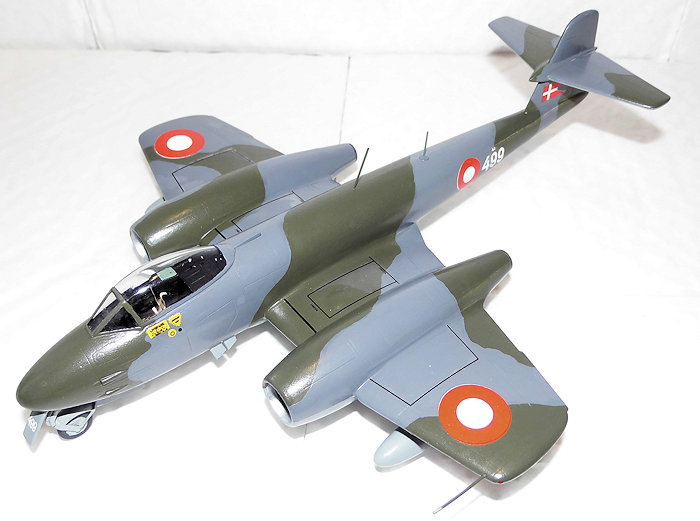 During assembling the cockpit
section, I decided to beef up the ejection seat by adding seat belts made from
Tamiya tape and also gave it some color after a description I found on the web.
During assembling the cockpit
section, I decided to beef up the ejection seat by adding seat belts made from
Tamiya tape and also gave it some color after a description I found on the web.
In the beginning the Danish F.8s had the small bore intakes and the canopy with the framed rear part, but later on they got the large bore intakes as well as the full blown canopy, so I chose to go that way and install these components.
Later, after I had glued the canopy in place, I discovered some plastic scrapings sitting on the inner side of the canopy (some of the photos included in this review may show it). WHAT??!! I thought I had secured it by cleaning both the cockpit and canopy with compressed air, but it was apparently not enough! I considered removing the canopy, because I actually had a spare one, since I had earlier build a British F.8 from Xtrakit (same mold!) where I had used the canopy with the metal plated rear. However, I found it too risky as some other things might break, too, and I wasnít in the mood to redo too much, so I left it as it was. But I wasnít pleased!
| COLORS & MARKINGS |
The painting was pretty much done in the same manner as my F.4 / T.7 builds so no need to repeat myself here.
The decals went down with
pretty much ease; as I had chosen to make 44-499 the decals came from various
sheets, most notably 72-127, but also 72-128 contributed while the kit decals
provided the walk ways, which was prominent on the real planes. In this case, I
also noticed that the roundels and flags
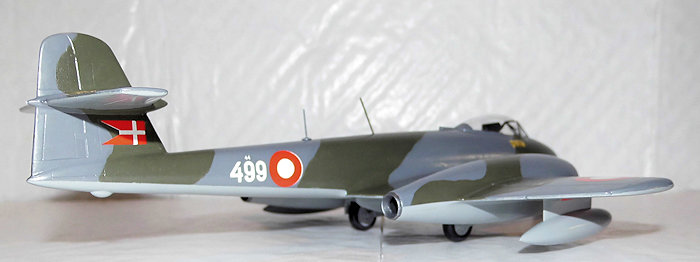 were slightly off register, but I
managed partly to reduce it by applying the appropriate colors to the edges of
especially the roundels (where the off register was most visible) with a very
fine brush and steady hand. On the roundel on the underside of the wings it was
very easy, since I discovered, I had to cut off some of the edge, so it would
fit against the tank pylon, as these had been glued in place before painting.
were slightly off register, but I
managed partly to reduce it by applying the appropriate colors to the edges of
especially the roundels (where the off register was most visible) with a very
fine brush and steady hand. On the roundel on the underside of the wings it was
very easy, since I discovered, I had to cut off some of the edge, so it would
fit against the tank pylon, as these had been glued in place before painting.
When the decals had dried they got a coat of gloss to ensure a uniform surface before giving the final coat of Humbrol Satin Cote for the satin sheen I was looking for.
The final bits consisted of attaching the gear doors, the ejector chutes for the spent shell casings and various antennas were attached with CA-glue and painted in their respective colors when dry. The last thing to do was to mark the position lights and the model was finished.
| CONCLUSIONS |
What can I say else than this kit is a welcome addition to model aircraft from the beginning of the jet age. As this kit has no locating pins / holes some experience is definitely needed, but if the skills are present it builds into a beautiful model of one of the pioneer jets.
| REFERENCES |
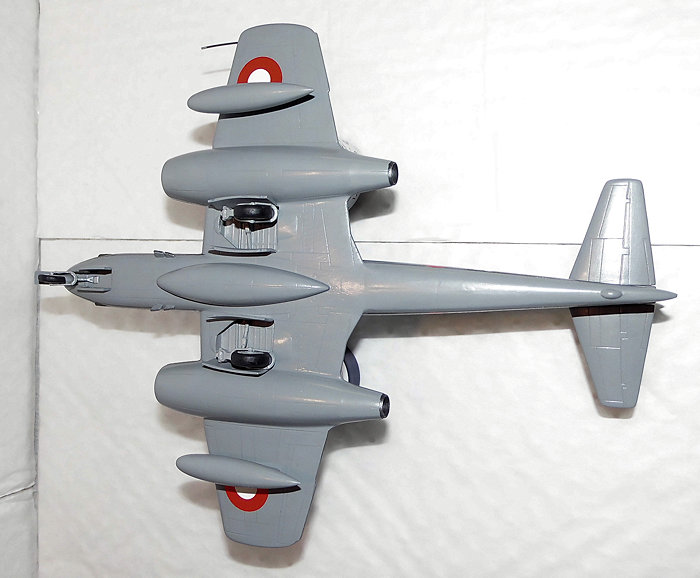 The publication Forsvarets fly
efter 1945 (Planes of the Danish armed forces after 1945) published by RDAF /
tinbox, 1987 edition was very helpful, but also various photos I found on the
web were helpful.
The publication Forsvarets fly
efter 1945 (Planes of the Danish armed forces after 1945) published by RDAF /
tinbox, 1987 edition was very helpful, but also various photos I found on the
web were helpful.
March 2016
Copyright ModelingMadness.com
If you would like your product reviewed fairly and fairly quickly, please contact the editor or see other details in the Note to Contributors.